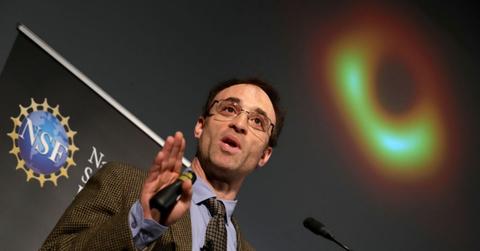Into the Unknown: Images of Black Holes Are Getting Better
Published July 7 2023, 12:05 p.m. ET

Perhaps a great memory from childhood is that of looking up into the stars and wondering about the vast mysteries held in the universe. The human race has long been fascinated with space, and that fascination leads to space exploration and research. The first image of a black hole was a breakthrough, but what do black holes have to do with Earth?
Black holes are dense, compact objects in space that have an intense gravitational pull. As National Geographic explains, a black hole's gravity is so strong that not even light can escape once it reaches within close enough range. Here's a look at that groundbreaking first image of a black hole, and a few other images of black holes that have been captured since.

The first picture of a black hole, taken using the Event Horizon Telescope.
When was the first image of a black hole created?
According to NASA, scientists were able to extract the first image of a black hole using the Event Horizon Telescope (EHT). In April of 2019, at an event organized by the National Science Foundation, the scientists involved revealed this first image to the world. This black hole is the one found at the center of the elliptical galaxy M87.
This particular black hole is located about 55 million light years from Earth. This first image revealed in 2019 shows the black hole "outlined by emission from hot gas swirling around it under the influence of strong gravity near its event horizon."
Images of the Messier 87 black hole were taken in 2023.
Progress in astronomy and technology continues, and the black hole images published in 2023 are evidence of that progress. In July 2023, SciTechDaily reported that an image captured aspects of the M87 black hole that were never before seen. Dr. Rosen Lu of the Shanghai Astronomical Observatory led the team that worked to produce this new image.
Here's what the 2023 black hole image depicts: the ring-like accretion structure around a black hole, which is where matter falls into the black hole. The image also shows the black hole’s associated relativistic jet. According to SciTechDaily, this image shows the connection between the accretion flow and the jet's origin.
Dr. Lu said that previous images showed the black hole separately from the jet, but now scientists have a panoramic view of them together.
“This shows that the material falling into the black hole produces additional emission that is now observed in the new image.This gives us a more complete view of the physical processes acting near the black hole,” Dr. Lu stated.
Other black hole images were taken in 2022.
As Event Horizon Telescope explains, another black hole image was created in 2022. The object had been known as Sagittarius A, or Sgr A*, and the team, call the Event Horizon Telescope (EHT) Collaboration, produced an image of this black hole using radio telescopes around the world. The image shows gas in a glowing orange ring surrounding the event horizon of the black hole.
Event Horizon Telescope noted that this black hole is about 27,000 light years away from Earth, much closer than M87. “Now we can study the differences between these two supermassive black holes to gain valuable new clues about how this important process works,” said Keiichi Asada from the Institute of Astronomy and Astrophysics, Academia Sinica, Taipei.